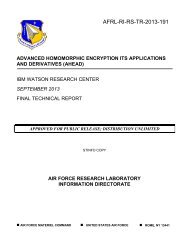EN100-web
EN100-web
EN100-web
You also want an ePaper? Increase the reach of your titles
YUMPU automatically turns print PDFs into web optimized ePapers that Google loves.
Research and Innovation<br />
account cross-layer considerations and multi-operator emergency<br />
environments. In terms of cryptographic functions,<br />
SIREN implements a family of key agreement methods with<br />
particular focus on password-based, weak to strong authentication<br />
associated with several multiparty contributory key<br />
agreement schemes.<br />
SIREN is also inspired by the opportunities and threats to the<br />
security of individuals owing to the convergence of the cyber<br />
and physical world, especially in urban environments.<br />
Increasingly within such environments, the everyday life of<br />
people takes place around cyber-physical objects that are<br />
becoming smarter and more inter-connected. This creates the<br />
possibility of continual acquisition, correlation and analysis of<br />
information that can improve citizen security and safety. It is,<br />
for example, possible to combine surveillance camera information<br />
with human physiological data and incident alerts created<br />
by mobile phone users in order to establish the occurrence<br />
of incidents and reacting to them on the spot and in a personalized<br />
manner. At the same time, the closer coupling of the physical<br />
world with cyber systems creates new threats and risks for<br />
people. Access to the location of individual (or groups of)<br />
people may, for instance, trigger targeted actions against them,<br />
and mass surveillance can compromise the privacy of individuals.<br />
Risks and threats may also increase significantly if functions,<br />
critical for the security and safety of citizens, depend on<br />
a cyber-physical infrastructure and Smart City applications<br />
that are not well protected against attacks (e.g., jamming communications<br />
between emergency responders).<br />
Enhancing these opportunities and managing the associated<br />
risks can be based on SIREN, which in the future will enable<br />
the development and runtime operation and management of<br />
different Cyber-Physical and participatory sensing applications,<br />
including aerial unmanned vehicles (drones), supporting<br />
the acquisition and sharing of security related information<br />
through the use of SIREN infrastructure. The SIREN<br />
platform will enable the development and runtime operation<br />
and management of such applications by offering an open<br />
and extensible set of integrated basic capabilities, with particular<br />
focus on emergency response and crisis management.<br />
Links:<br />
http://www.redcomm-project.eu<br />
http://www.secocard.ch/<br />
References:<br />
[1] A. Miaoudakis et al.: “Communications in Emergency and<br />
Crisis Situations”, Distributed, Ambient, and Pervasive Interactions,<br />
Springer International Publishing, 555-565, 2014.<br />
[2] I. Askoxylakis et al.: “A Rapid Emergency Deployment<br />
Mobile Communication Node”, IEEE Computer-Aided<br />
Modeling Analysis and Design of Communication Links<br />
and Networks (CAMAD), 2014<br />
[3] P. Papagrigoriou, et al.: “Discrete Hardware Apparatus<br />
and Method for Mobile Application and Communication<br />
Security”, Human Aspects of Information Security, Privacy,<br />
and Trust. Springer International Publishing, 102-112, 2014.<br />
Please contact:<br />
Ioannis Askoxylakis, FORTH-ICS, Greece<br />
E-mail: asko@ics.forth.gr<br />
MYvISItPLANNER: Cloudbased<br />
Recommender<br />
for Personalized tourism<br />
by Ioannis Refanidis and Christos Emmanouilidis<br />
Following the masses is one way of being a tourist. But<br />
the modern creative tourist is eager to forge a personal<br />
trail. Tailoring an itinerary to individual desires has<br />
always been the realm of highly specialized tour<br />
operators. Context-aware computing and recommender<br />
systems make it possible to offer personalized services<br />
in tourism. MYVISITPLANNER is a cloud-based service<br />
employing a recommender engine to offer personalized<br />
suggestions for tour activities and a planning tool to<br />
create appropriate tour itineraries. Recommendations<br />
are offered on the basis of a hybrid approach that takes<br />
into account both a taxonomy of possible activities, as<br />
well as user preferences and past recommendations,<br />
thus offering recommendations tailored to the visit<br />
profile [1].<br />
A creative tourist is a traveller who is not simply satisfied<br />
with visiting top-10 attractions but seeks to enjoy a personal<br />
experience when visiting a place. Whether the visit involves<br />
outdoors activities off the beaten track or certain cultural<br />
preferences, an individual traveller is often a more<br />
demanding tourist but also one that intends to better blend<br />
with local culture and people when travelling. The personalization<br />
of the tourist product can now be achieved by<br />
advanced computer-assisted tourism services.<br />
Visitors may obtain: (i) activity recommendations contextualized<br />
by the time, duration and area of a visit, as well as by<br />
personal preferences and visit profiling; and (ii) tour itineraries<br />
created by a world-class scheduler, on the basis of the<br />
offered recommendations, while taking into account individual<br />
visitor calendar constraints and scheduling preferences,<br />
as well as available time for the visit. Activity<br />
providers can benefit from having their services enlisted and<br />
included in the itineraries recommendations (Figure 1).<br />
While many recommender systems base their recommendations<br />
on either distance-based retrieval principles or collaborative<br />
filtering performed over past evaluations, the MYVIS-<br />
ITPLANNER cloud service employs a hybrid recommender<br />
engine that fuses both approaches and is thus able to offer<br />
relevant recommendations even in the absence of historical<br />
data and past user evaluations feedback (Figure 2).<br />
In the absence of past visit data, the recommendations are<br />
based on a dedicated activities ontology. Specifically, a new<br />
visit profile is mapped on the activities ontology and, based<br />
on a dedicated distance function, relevant recommendations<br />
are retrieved. Past user evaluations are handled by hybrid<br />
clustering performed over the cloud employing the Mahout<br />
cloud-oriented machine learning library. Special care is<br />
taken so that privacy-preserving data management is<br />
involved: visit profiling is preferred instead of user profiling,<br />
avoiding handling sensitive private data. The user has the<br />
46<br />
ERCIM NEWS 100 January 2015



